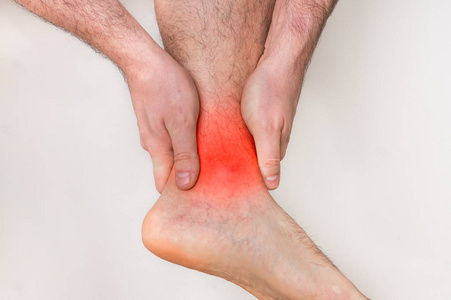
You’ve had a long day. You kick off your shoes, put your feet up, and notice it again—that familiar, puffy tightness around your ankles. When you press your finger into the skin, a dent remains for a few seconds. It’s become a daily occurrence, something you’ve maybe started to write off as “just part of getting older.” You might blame the heat, a long day on your feet, or that salty meal you had for lunch.
And while those things can certainly contribute, when swelling becomes a persistent, daily fact of life, it’s your body’s way of sending a signal that can’t be ignored. Swollen ankles daily? Your heart is weak… in its pumping power, and fluid is backing up in your system.
Let’s be very clear: this is not meant to incite panic, but to empower you with knowledge. That swelling, known as edema, is a crucial clue. It’s not just water retention; it’s a sign that your body’s most vital pump may be struggling to keep up with demand.
The Plumbing Problem: A Failing Pump
Think of your heart as the powerful pump at the center of a complex plumbing system—your circulatory system. With every beat, it sends oxygen-rich blood through your arteries to every part of your body, including your feet. The blood then travels back to the heart through your veins, a journey that requires it to work against gravity from your legs and ankles.
When your heart is strong, this system works efficiently. But when the heart muscle becomes weak or damaged—a condition known as Heart Failure—it can’t pump blood forward as forcefully as it should.
Here’s what happens:
- Blood Backs Up: Because the heart isn’t ejecting blood effectively, blood begins to “back up” in the system, like a traffic jam on a highway.
- Pressure Builds: This backup increases the pressure in the veins, particularly the ones farthest from the heart—those in your legs and ankles.
- Fluid is Forced Out: This increased pressure pushes fluid out of the tiny blood vessels (capillaries) and into the surrounding tissues. This is the swelling you see and feel.
So, the swollen ankles are a visible sign of a circulation backup caused by a heart that’s no longer pumping at full strength. The term “heart failure” sounds scarier than it often is; it means the heart isn’t failing to stop, but that it’s failing to keep up with the body’s needs.
Beyond the Heart: Other Culprits to Rule Out
While congestive heart failure is a primary concern, a good doctor will rule out other conditions that can cause similar swelling.
- Venous Insufficiency: The tiny valves in your leg veins that help push blood upward can become weak with age, allowing blood to pool in the legs. This is a plumbing problem in the veins themselves, not the heart.
- Kidney Disease: Your kidneys are responsible for regulating fluid and salt balance. If they aren’t working properly, fluid can build up in the body, often showing up as puffiness around the eyes in the morning and in the ankles later in the day.
- Liver Disease: The liver produces a protein called albumin, which helps keep fluid in the blood vessels. Severe liver damage can lead to low albumin levels and subsequent fluid leakage.
- Medication Side Effects: Common medications for high blood pressure (like calcium channel blockers), diabetes, and pain (NSAIDs) can all cause fluid retention as a side effect.
The Red Flags: When to Act Immediately
Swollen ankles alone might warrant a doctor’s appointment, but if they are accompanied by any of the following symptoms, it could signal a more urgent situation. Seek medical attention immediately if you have swelling plus:
- Shortness of breath, especially when lying down flat.
- Difficulty breathing or waking up gasping for air.
- A persistent cough or wheezing.
- Swelling that is painful, red, or warm to the touch (could indicate a blood clot).
- Sudden, significant weight gain from fluid retention.
Your Action Plan: From Swelling to Solutions
If you’re experiencing daily swollen ankles, your course of action is clear.
- Schedule a Doctor’s Appointment: Don’t dismiss this as a normal part of aging. Tell your doctor, “I have persistent, daily swelling in my ankles, and I’m concerned about my heart and kidney function.”
- Keep a Log: Note when the swelling is worst, what you’ve eaten, and any other symptoms you feel. This is invaluable for your doctor.
- Expect Simple Tests: Diagnosis typically involves a physical exam (listening to your heart and lungs), blood tests to check your kidney and liver function, and often an echocardiogram—a simple, non-invasive ultrasound of your heart that shows its size, structure, and, most importantly, its pumping strength.
- Make Lifestyle Tweaks (Under a Doctor’s Guidance):
- Reduce Salt Intake: Salt makes your body hold onto water. This is the most critical dietary change.
- Elevate Your Legs: When resting, try to have your feet above the level of your heart.
- Stay Active: Gentle movement like walking helps pump fluid out of the legs.
Daily swollen ankles are your body’s way of waving a red flag. It is a visible plea for you to pay attention to the engine room of your body. While the cause may be something other than your heart, assuming it’s “nothing” is a risk you should not take. By listening to this signal and seeking a professional diagnosis, you are taking a powerful, proactive step to protect your health, manage any underlying conditions, and ensure your heart can keep supporting you for all the journeys yet to come.